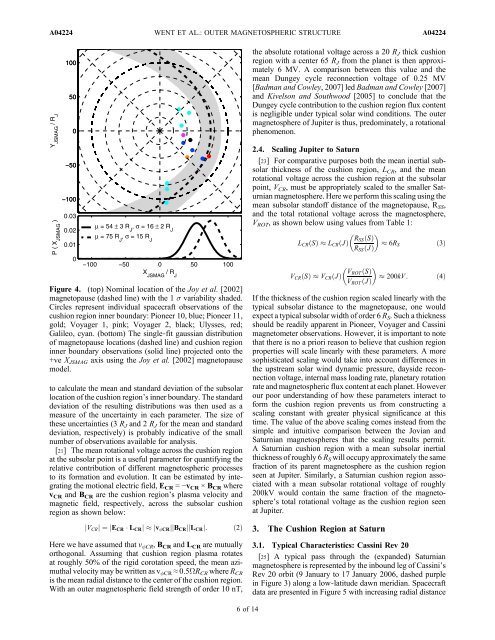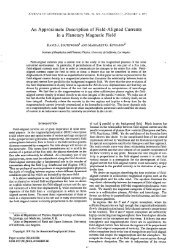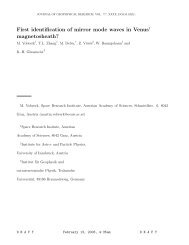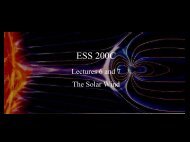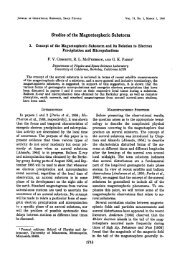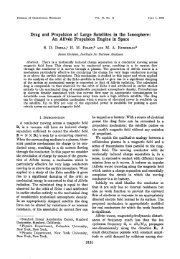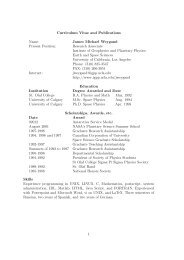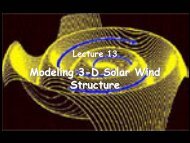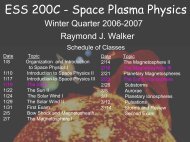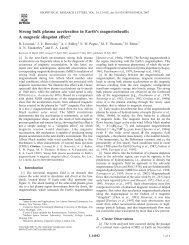Outer magnetospheric structure: Jupiter and Saturn compared
Outer magnetospheric structure: Jupiter and Saturn compared
Outer magnetospheric structure: Jupiter and Saturn compared
Create successful ePaper yourself
Turn your PDF publications into a flip-book with our unique Google optimized e-Paper software.
A04224<br />
WENT ET AL.: OUTER MAGNETOSPHERIC STRUCTURE<br />
A04224<br />
the absolute rotational voltage across a 20 R J thick cushion<br />
region with a center 65 R J from the planet is then approximately<br />
6 MV. A comparison between this value <strong>and</strong> the<br />
mean Dungey cycle reconnection voltage of 0.25 MV<br />
[Badman <strong>and</strong> Cowley, 2007] led Badman <strong>and</strong> Cowley [2007]<br />
<strong>and</strong> Kivelson <strong>and</strong> Southwood [2005] to conclude that the<br />
Dungey cycle contribution to the cushion region flux content<br />
is negligible under typical solar wind conditions. The outer<br />
magnetosphere of <strong>Jupiter</strong> is thus, predominately, a rotational<br />
phenomenon.<br />
2.4. Scaling <strong>Jupiter</strong> to <strong>Saturn</strong><br />
[23] For comparative purposes both the mean inertial subsolar<br />
thickness of the cushion region, L CR , <strong>and</strong> the mean<br />
rotational voltage across the cushion region at the subsolar<br />
point, V CR , must be appropriately scaled to the smaller <strong>Saturn</strong>ian<br />
magnetosphere. Here we perform this scaling using the<br />
mean subsolar st<strong>and</strong>off distance of the magnetopause, R SS ,<br />
<strong>and</strong> the total rotational voltage across the magnetosphere,<br />
V ROT , as shown below using values from Table 1:<br />
<br />
L CR ðSÞ L CR ðJÞ<br />
R <br />
SSðSÞ<br />
6R S<br />
ð3Þ<br />
R SS ðJÞ<br />
Figure 4. (top) Nominal location of the Joy et al. [2002]<br />
magnetopause (dashed line) with the 1 s variability shaded.<br />
Circles represent individual spacecraft observations of the<br />
cushion region inner boundary: Pioneer 10, blue; Pioneer 11,<br />
gold; Voyager 1, pink; Voyager 2, black; Ulysses, red;<br />
Galileo, cyan. (bottom) The single‐fit gaussian distribution<br />
of magnetopause locations (dashed line) <strong>and</strong> cushion region<br />
inner boundary observations (solid line) projected onto the<br />
+ve X JSMAG axis using the Joy et al. [2002] magnetopause<br />
model.<br />
to calculate the mean <strong>and</strong> st<strong>and</strong>ard deviation of the subsolar<br />
location of the cushion region’s inner boundary. The st<strong>and</strong>ard<br />
deviation of the resulting distributions was then used as a<br />
measure of the uncertainty in each parameter. The size of<br />
these uncertainties (3 R J <strong>and</strong> 2 R J for the mean <strong>and</strong> st<strong>and</strong>ard<br />
deviation, respectively) is probably indicative of the small<br />
number of observations available for analysis.<br />
[21] The mean rotational voltage across the cushion region<br />
at the subsolar point is a useful parameter for quantifying the<br />
relative contribution of different <strong>magnetospheric</strong> processes<br />
to its formation <strong>and</strong> evolution. It can be estimated by integrating<br />
the motional electric field, E CR = −v CR × B CR where<br />
v CR <strong>and</strong> B CR are the cushion region’s plasma velocity <strong>and</strong><br />
magnetic field, respectively, across the subsolar cushion<br />
region as shown below:<br />
jV CR j¼jE CR L CR jjv CR jjB CR jjL CR j:<br />
Here we have assumed that v CR , B CR <strong>and</strong> L CR are mutually<br />
orthogonal. Assuming that cushion region plasma rotates<br />
at roughly 50% of the rigid corotation speed, the mean azimuthal<br />
velocity may be written as v CR ≈ 0.5WR CR where R CR<br />
is the mean radial distance to the center of the cushion region.<br />
With an outer <strong>magnetospheric</strong> field strength of order 10 nT,<br />
ð2Þ<br />
<br />
V CR ðSÞ V CR ðJÞ<br />
V <br />
ROT ðSÞ<br />
200kV:<br />
ðJÞ<br />
V ROT<br />
If the thickness of the cushion region scaled linearly with the<br />
typical subsolar distance to the magnetopause, one would<br />
expect a typical subsolar width of order 6 R S . Such a thickness<br />
should be readily apparent in Pioneer, Voyager <strong>and</strong> Cassini<br />
magnetometer observations. However, it is important to note<br />
that there is no a priori reason to believe that cushion region<br />
properties will scale linearly with these parameters. A more<br />
sophisticated scaling would take into account differences in<br />
the upstream solar wind dynamic pressure, dayside reconnection<br />
voltage, internal mass loading rate, planetary rotation<br />
rate <strong>and</strong> <strong>magnetospheric</strong> flux content at each planet. However<br />
our poor underst<strong>and</strong>ing of how these parameters interact to<br />
form the cushion region prevents us from constructing a<br />
scaling constant with greater physical significance at this<br />
time. The value of the above scaling comes instead from the<br />
simple <strong>and</strong> intuitive comparison between the Jovian <strong>and</strong><br />
<strong>Saturn</strong>ian magnetospheres that the scaling results permit.<br />
A <strong>Saturn</strong>ian cushion region with a mean subsolar inertial<br />
thickness of roughly 6 R S will occupy approximately the same<br />
fraction of its parent magnetosphere as the cushion region<br />
seen at <strong>Jupiter</strong>. Similarly, a <strong>Saturn</strong>ian cushion region associated<br />
with a mean subsolar rotational voltage of roughly<br />
200kV would contain the same fraction of the magnetosphere’s<br />
total rotational voltage as the cushion region seen<br />
at <strong>Jupiter</strong>.<br />
3. The Cushion Region at <strong>Saturn</strong><br />
3.1. Typical Characteristics: Cassini Rev 20<br />
[25] A typical pass through the (exp<strong>and</strong>ed) <strong>Saturn</strong>ian<br />
magnetosphere is represented by the inbound leg of Cassini’s<br />
Rev 20 orbit (9 January to 17 January 2006, dashed purple<br />
in Figure 3) along a low‐latitude dawn meridian. Spacecraft<br />
data are presented in Figure 5 with increasing radial distance<br />
ð4Þ<br />
6of14


